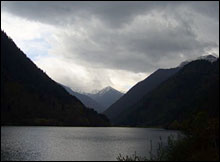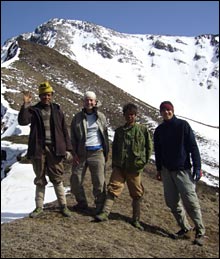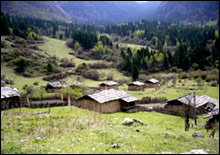Eric Wagner is a graduate student in biology at the University of Washington. He reports from China, where a group of students and faculty from UW and Sichuan University is working to help create a management plan for a popular national park.

Saturday, 22 Apr 2006
On the road, Sichuan Province, China
“It’s weird,” Yuh-Chi Niou says to me as our bus bounces and rattles its way across the Chinese countryside. “The words they use to describe Jiuzhaigou come out in English as ‘fairyland’ or ‘heaven.’ They do sound kind of silly.”

A little slice of heaven.
Photos: Eric Wagner.
An undergraduate at the University of Washington, Niou is talking about her recent feat of translating an introduction to Jiuzhaigou National Nature Reserve, where we are headed. I’ve just flipped through it, and am asking about the verbal excess. “Fairyland” seems just too, oh, Tony Robbins trying to make the park feel good about itself. (“You’re a fairyland! Believe it and it’ll be true!”) Nothing could be that amazing.
But when we arrive at the park six hours later and I stumble out of the bus and see what everyone has been trying to describe, I forgive the hyperbole.
Jiuzhaigou Reserve, in Sichuan province, is one of the best-known national parks in China. It encompasses about 280 square miles of mountains and waterfalls, lakes and forests, with elevations that range from 6,000 to nearly 16,000 feet. This results in a suite of habitats, and the park is home to an impressive collection of biota. It is one of the last places to see a giant panda in the wild, as well as the golden monkey — two of China’s more high-profile endangered species.
The Chinese government created the park in 1978. After it opened to the public in the early 1980s, about 5,000 people visited annually. Today, about 7,000 come in a single day. The increase is due to a series of designations starting in the 1990s, when the park caught the world’s keen green eye. It was named a UNESCO World Heritage Site in 1992, a World Biosphere Reserve in 1997, and is certified as sustainable by Green Globe 21. (Jiuzhaigou is China’s only park to have all three designations.)

Will tourists crowd out views like this?
These accolades have had a marked impact. Last year, more than 2 million people passed through the entrance gates. This year, the park aims to raise that number by half a million more. And those people will want places to sleep and eat. They’ll want to see the amazing views that travel agents promise with their colorful brochures. And they’ll want to do all of this in a fragile landscape that isn’t especially suited to handling so much sustained human traffic.
This is where Niou and I (and several others) come in. We’re part of a contingent of students and faculty from the University of Washington and Sichuan University in Chengdu, China. Pitching along with us on the bus was a crew of engineers, chemists, ecologists, anthropologists, and archaeologists. We’re all here because of UW Worldwide, a program sponsored by UW that’s designed to foster multinational collaborations in research, education, and service.
Over the next nine days, we’ll work with the park’s science staff on projects ranging from wastewater management to environmental monitoring. Our goal is to help the park develop a more comprehensive management plan for its natural and cultural resources.
And on that note, one small bit of trivia: “Jiuzhaigou” literally means “Valley of Nine Villages.” All of those villages, some of which are still inhabited, were Tibetan, and speak to the uneasy relationship between the park’s conservation goals and the area’s original residents.
But that’s a story for tomorrow. My stomach is still recovering from the bus ride, and I want to play tourist for a couple more minutes. I’ll test my camera’s robust promise to capture “the unique essence of your chosen image,” or something like that. Most of my photos will turn out to be some variation on two ridges converging into a valley with an awesome peak towering behind. At slide shows to come, conscripted family and friends may wonder why I took the same picture 800 times. But I will remember that each shot was, at the time, both singular and spectacular.
Watch Your Yak
Officially, there are no yaks in the Jiuzhaigou National Nature Reserve. They haven’t been allowed within park boundaries for several years now. Even so, when I stepped in a large pile of yak slop on the first day of a backpacking trip, I was not terribly surprised.
I was on the trip as part of Shengtai Yi (“Ecology 1”), along with Gus Jespersen, Erin Hagen, and Kimberly Sheldon. We’re grad students at UW — they in alpine, avian, and physiological ecology, respectively; I’m the estuarine ecologist of the group. (The estuaries at 13,000 feet being so amazing, after all.) Tom Hinckley was also with us. A professor of forest ecology at UW, he’s perhaps the fittest sexagenarian I know.
We were paced by Andrew Scanlon, an Irish fellow working for the German government in a Chinese park. He, Erin, and Tom would hike in with us to lighten our early load of food and gear. Gus, Kimberly, and I would then continue into the backcountry for three or four more days.
Our trek would take us through the northeastern portion of the park, currently off-limits to visitors. That is about to change: the park plans to open an ecotourism trail next July. Most Chinese tourists, Andrew says, are content to “ride a bus, take a picture, buy a souvenir, and go home.” This new attraction will take those who want to get off the bus and around the mountains on a guided trek.
Park managers want to pack in as many as 500 people per kilometer, which will no doubt have an impact on a place that some visitors are asked to pay more than 1,000 RMB (about $125) per day to see. Currently, the park doesn’t have a standardized protocol to monitor the impacts of its visitors. Gus, Kimberly, and I were to hike the proposed trail, marking GPS waypoints and habitat boundaries. We would also document whatever plants and wildlife we could. When we returned, we would work with park staff to develop a rigorous monitoring protocol.
This area of the park is supposed to be uninhabited, but it wasn’t long before signs started to appear. The yak poop, for instance, and the yaks themselves. Lean-tos surrounded by a debris field of plastic bottles. A large, temporarily abandoned hut on a slope.
According to park policy, none of this exists. But try telling that to the Tibetans who regularly use the mountain. Make sure to mention to the people scouring the hillside that collection of natural resources is not allowed, and that it’s illegal to come into the park through unsanctioned entrances like the high ridge where we saw them.

An unexpected encounter.
Photo: Eric Wagner.
As often happens with fieldwork, external forces changed our plans. Gus, Kimberly, and I had just hit the ridge one late afternoon when a couple of the Tibetans we’d seen spirited over to say hello. One looked to be in his mid-20s; the other couldn’t have been more than 15. They flopped on the grass next to us, offered their disk of bread, and showed us the medicinal roots they had dug up that morning, stuffed in a cigarette pack. (Andrew later told me that a kilo of the root nets close to $200 — a good monthly salary in this part of the country.)
They gestured at mountains that stretched for miles and flashed a thumbs-up. We nodded back. The view was indeed spectacular. Because our shared vocabulary consisted of “hello,” “let’s go,” “bye,” and “Jiuzhaigou,” we focused on the last one, trying to tell them where we’d come from. I’m still not entirely certain, but I think they thought we were lost. “Jiuzhaigou!” they said, pointing over a mountain and grinning. We smiled back wanly — we’d been hiking for six hours at high altitude and were tired. Of course, our new companions had been up both far longer and far higher.
A third Tibetan loped over, and they motioned for us to follow. They hiked fast, but their leisurely steps made it seem as if they were out for a casual stroll, which did little for morale. I was soon panting and heaving and showing especial interest in stopping to photograph a yellow flower.
Eventually, our companions decided we were going too slowly. They mimed for us to take off our packs, which they shouldered. They pointed down an impossibly steep slope. They would take us to their village, where we could camp and be fed, if we liked.
I’ll be curious to see how the park and the Tibetans reconcile their disparate land ethics, or if they can. So far, the government has contented itself with paying the Tibetans up to 7,000 RMB a year to phase out their poaching practices — a program that is expected to end next year.
But as I scrambled down the slope, watching the Tibetans carry my pack and chain-smoke and search for roots and still easily outstrip me, conservation wasn’t my first concern. I’m growing more accustomed to these delicate contradictions — between what I read and what I see, between what is said and what is stuck in the treads of my boot.
All Good Things Must Come to an End
Wednesday, 3 May 2006
Jiuzhaigou National Nature Reserve
I felt a strange melancholy when I woke up this morning, my next-to-last in Jiuzhaigou National Nature Reserve. I suppose it was inevitable, given the intensity of the past nine days. Still, it seemed that the day was intent on preventing happiness. Clouds hung over the mountains and drifted among the trees. Usually, they have the decency to wait until evening. Also, it was raining. We’d been told we’d miss the rainy season, but apparently it started early to make sure we’d get a taste, no matter how fleeting. (An uncanny condition of my last day anywhere is that it always rains.)

Abandoned Tibetan village.
Yesterday was Teaching and Training Day. All the students went for a hike with park staff into the Hai Jaei valley. James Taylor, a UW archaeology grad student, and Chen Shi, an undergrad anthropologist from Sichuan University, had spent much of their week in an abandoned Tibetan village up in the valley. The village has one inhabitant, an old half-deaf, half-mute Tibetan man. “You should see how he can talk with his hands,” James told us. “It’s amazing — any little tool I show him, he can demonstrate exactly what it does through sign language, and how it’s made. He built the house he lives in.”
Our ecology group had hiked up at 7 a.m. to set up vegetation plots. In our days here, we’ve found that while the park monitors a lot of environmental parameters, they sometimes do so in helter-skelter fashion. Having a database of standardized observations would be helpful. Although the park was started in 1978, they’ve only begun monitoring things such as forest health within the past few years. Sometimes that data goes unanalyzed for a while. We thought we’d give them some additional quick, easy ways to determine the state of their forests, among other things.
The science staff arrived around 10 a.m. Amanda Henck, a geology grad student, started the day with a show of some GPS tricks; James talked about the importance of preserving cultural resources; and our group talked about things like fuel moisture indices (which determine forest fire risk); forest basal area monitoring (a measure of stand health); belt transects (which help monitor human impacts on vegetation); and tree coring (to find stand age). Then we all picked up litter, and then it was time to go home.
We spent most of our last full day in the Jiuzhaigou with the science staff, talking about what we’d learned this year and what could make next year more successful. And then it was off to our last formal dinner. (We knew it was formal because our Irish guide, Andrew Scanlon, wore a sport jacket — his father’s father’s — over his usual sweatshirt and hiking pants.)

Prof. Tom Hinckley (left) demonstrates the use of a fuels moisture monitor.
As much as I appreciate the food here, I’m now wary of Chinese formal dinners. They’re great fun, but they quickly dissolve into rather straightforward drinking rituals under the guise of toasts. Through a set of rules that I still don’t understand, you’re not allowed to drink liquid of any sort unless you raise a glass to someone or they raise one to you. So you’ll be picking at something with chopsticks, and suddenly someone taps you on the shoulder. (The strength of the tap correlates strongly with the lateness of the evening.) Turning around, you’ll see someone you may or may not know who may or may not be able to focus on you. “To you!” they’ll say if they can’t think of another reason, and they drain their glass, and you do, too, because that’s how it’s done. And then off they go to find someone else. And you return to the chopsticks, which have been getting harder and harder to use as the night goes on.
Especially pernicious is when a table decides to “target” someone, sending a stream of people one after another to toast a victim to the floor. The UW students tried to do this to forest ecology professor Tom Hinckley, but he outmaneuvered us by drinking tasty yogurt-milk. I guess that’s why he has tenure.

